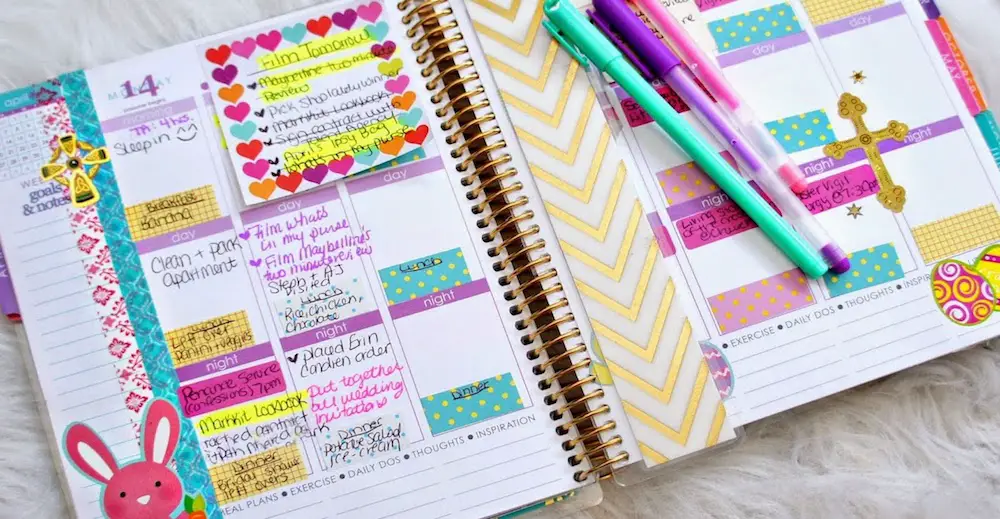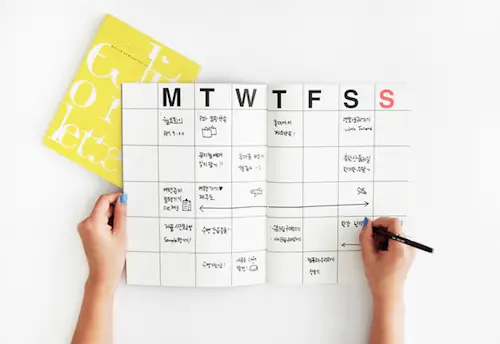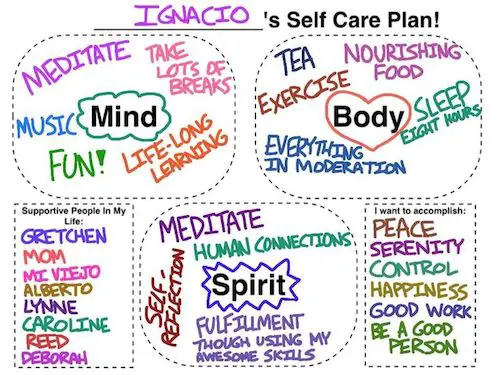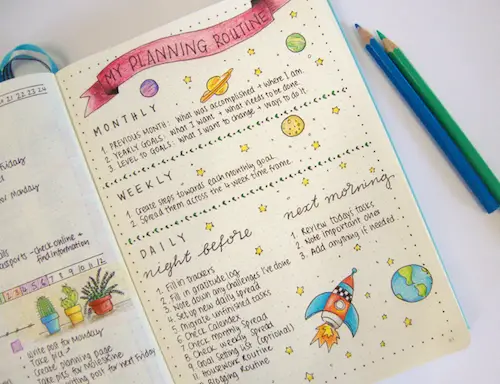Are you a procrastinator? Raise. Your. Hands. Let me see ’em! Believe me – I can relate. If you’ve spent enough time putting off big tasks for later, you’ve probably also spent a considerable amount of time searching for the magic key to boundless productivity, motivation and discipline.
If you’ve come here on just that mission, I’m going to warn you that I don’t have the answer. I’m also going to ask that if you find it, to please send it my way.

However, there are ways to combat procrastination and nip it in the bud. The technique is simple, accessible, and it doesn’t have to be time-consuming.
Maybe you’re already used to writing things down in your planner or calendar, but you still find yourself having trouble focusing on tasks and goals. If you’re too busy with no time to spare, you’re likely standing in your own way.
After all, I should remind you that it does take time to procrastinate in the first place!
1. Set aside the time to plan

This step is first and foremost, and you cannot skip it. I would highly recommend not putting this one off or going at it with low effort. This hour of your day determines so much about the next seven days.
The process is WORTH IT. Schedule it somewhere into your weekend, or at the very latest, do it on Monday morning. This process should be mindful and somewhat enjoyable.
Choose a format that resonates with you, or the one you’re most likely to use. I personally use a handwritten calendar in conjunction with many online organization tools for my work. Your method should suit you, your tasks, your work and your lifestyle!
Using a calendar on the computer or phone can be helpful to those who have many repeated events because drag and drop is a breeze.
Some people are more likely to follow through with actual checklists and the ability to physically mark the tasks done. Some people like a little bit of both.
If you come back to it each week and you pay it some mind each day, it’s probably working. Stick with it. If you tend to neglect your schedule, perhaps it’s time to try a new strategy.
2. Choose an appropriate level of detail

Planning should take into account your individual needs. Sure, these pretty planners and all of these meticulously organized bullet journalers on Instagram have a color code and a Washi tape for everything, but if it’s just not your jam, or it intimidates you too much to keep up with using your preferred method of planning consistently, forget about it.
Determine the level of detail that keeps you motivated, sufficiently methodized and tabulated and routinely crossing things off the list.
Take a few things into consideration: do you need to plan by the hour or by the day? Will you do better with a weekly calendar broken down into individual days, or do you just need one?
Do you need to write down specific objectives or big ideas? Will you use a digital format, or will you opt for pen and paper? Then, get into smaller details: do you prefer a template like the Panda Planner, or do you prefer to build your own?
Will you benefit from using a color code, or do you keep it simple with black and white? Think about what speaks to you the most.
3. Embrace flexibility

Flexibility is something to be welcomed in both your planning technique and your plan. It gives us room to breathe, first and foremost, and helps us scale back on black and white “perfectionist” thinking.
If life always went according to plan, we probably wouldn’t have to plan so hard in the first place. Besides, what fun would that be? Leave room for error, running out of time and good old-fashioned spontaneous fun.
4. Work backwards

Match your time to your work rather than fixing work to your time. There’s only so much time in the day, and you should be setting healthy boundaries anyways! Prioritize your calendar over your to-do list.
Repeat it to yourself: there is only so much time in the day. Twenty-four short hours to be exact, and during some of those, you should very well be asleep.
Quit overbooking, and you won’t find quite as many reasons to procrastinate because a) you won’t be overwhelmed and b) you won’t have a huge overflow each week from tasks you didn’t get to.
5. Start un-planning

To elaborate a bit on working backwards and how effective it can be, un-planning takes a similar approach to planning. Sounds like an oxymoron – right?
Un-planning consists of scheduling into your calendar or journal all of the things you have to do outside of work, personal development, hobbies or whatever else you make space for.
Think about the time it takes you to feed or bathe the kids, walk the dog, make coffee and breakfast and whatever other mundane, default activities you are obliged to for one reason or another.
You’ll see that despite our best efforts, we have non-negotiables to tend to that carve into our “productive” time. By losing that time living life, we set up unrealistic expectations (more on that later), end up “late,” and perpetuate that procrastination mind because *gasp* we’re already behind!
Instead, just take some time to pencil in the moments when you can’t be tending to your schedule. This is especially useful for those who work remotely because starting time isn’t always the FIRST thing we’re able to do.
6. Schedule beyond tasks

While un-planning takes care of the mundane for us – or rather, we accept it for what it is – scheduling beyond tasks helps us to take good care of ourselves. It drives home the idea that self-care is just as important to prioritize as that big work project or whatever deadline is looming over our heads.
This will also look different for everyone, but without placing precedence on things like a certain amount of sleep each night, time to cook healthy food, meditation, exercise and social interactions, we’re going to feel FAR less motivated to tackle those not-so-fun to-do tasks!
It’s vital to create space for fulfilling routines. Procrastination is driven by the idea that we don’t have time, so creating personal time can feel really difficult for some when in fact, it could be the solution to having more time.
When we feel fulfilled, refreshed and energized by meeting our basic human needs which include the occasional bubble bath, day trip and friendly potluck, our creative forces are sparked and our energy is higher, ultimately granting us with a will to be more productive – and happily so!
Include in your planner a focus on your values, beliefs and toss in some inspiration here and there.
7. Be realistic

Nothing will make you feel like you’re not pulling your weight and being productive than over planning. You know yourself better than anyone else, and to some extent, you’re in control of your schedule.
First and foremost, think of what doesn’t work! Come back to the amount of time you DO have and work with it. Make friends with it. Shake its hand and give it a hug. Respect it and plan accordingly.
Being overbooked not only presents us with logistical problems, but it also creates more problems the more often we indulge it. We feel obligated to do x, y and z, and it drives home that FOMO or fear of missing out.
We’re less inclined to say NO even when we need to. We end up with heavy duty overflow each week, and we end up behind and feeling like catching up is an impossibility. If we’re realistic, we can avoid the guilt and once again, perpetuating procrastination.
8. Don’t forget to check in

Sometimes, I’m in the middle of a work day and I remember that my planner even exists. It’s a feeling I quite like, because I can head back into the schedule and check stuff off the list.
If I was that distracted, I’ve probably made some serious progress! It’s good to continually check in. My usual routine involves my planner open to its most relevant page – whether it’s my daily checklist or my current project brainstorm – for quick and easy reference.
It helps me to maintain focus and stay motivated. Think of it as your personal accountability coach. If it were a real person, it might be concerned if it didn’t hear from you for awhile! Don’t wing it – use your resources wisely.
Besides, sometimes, we start getting dragged down. Occasionally doing a mind dump – where you sort of shift priority, let go of some brain clutter and readjust – can be incredibly helpful and just the push you need to keep it happy, healthy and productive.
9. Make it fun!

My planner isn’t an all work and no play kind of deal. Of course, how much “fun” you inject into the mix is going to depend on how much it might distract you, but once again – the plan shouldn’t be 100% task-oriented.
Create space to write down personal goals both long-term and short term. For example, my journal includes a habit tracker to mark off my meditations and exercises each day.
I also use a reading progress tracker in mine so I’m more motivated to make space to read for both pleasure and personal development. Finally, I enjoy supplementing my to-do lists with more obtuse goals so that my work doesn’t lose meaning or feel monotonous.
If your planner is fun, you’re going to like it more. The more you like something, the more you’re going to do to make it happy. That’s what love is all about, right?
It’s okay to have a *minor* love affair with your calendar. Another good way to make planning interesting is to use fun, colored pens, highlighters and stickers to add your own flair to your routine.
10. Don’t leave home without your plan

This is why I would generally recommend a small planner like the Moleskine I use because it fits in my backpack, my purse and even many of my pockets. Without a plan, you’re merely hoping.
There’s no better time to lose focus than when you’re out and about, traveling or just always on the go! While it’s helpful to unplug sometimes, I personally like to make sure my basic self-care needs are met even if I’m breaking from work and to-do lists.
If you tote your planner around, you can always maintain that feeling of calm and control. It’s a good one.
Let me ask you – what is YOUR number one tip for reducing procrastination and staying organized by planning? Share your ideas and tips with us below, and share this article if you found it helpful! Happy planning.
Music, mountains, dogs, travel, food and friends.

